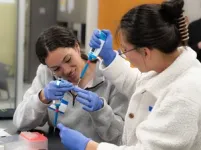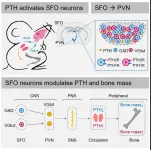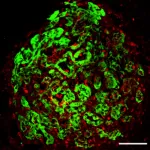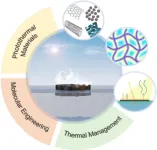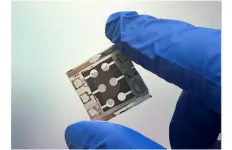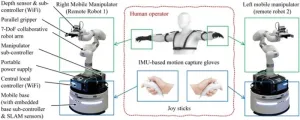(Press-News.org) Chitin (kai’tin) and healthy fats from insects appear to contribute to healthy gut microbiota and are strong sources of protein and nutrients, according to a paper co-authored by a Colorado State University researcher and published in Nature Food.
Tiffany Weir, an associate professor in CSU’s Department of Food Science and Human Nutrition, co-authored the paper with the University of Wisconsin’s Valerie Stull. They pioneered human research on cricket consumption’s effect on gut microbiota.
Weir said that her and Stull’s earlier research helped spawn Weir’s latest study of how cricket-derived chitin in designer chocolate patties may increase positive prebiotic effects on individuals with irritable bowel syndrome.
“Edible insects and insect fibers may be unusual in the American diet, but they are commonplace around the globe, as insects are part of many traditional cuisines,” Stull said. “They are gaining attention as an environmentally friendly source of animal protein.”
A previous study referenced in the paper estimated 3,000 ethnic groups in 130 countries eat insects mostly harvested in the wild. But insect farming also is growing in popularity as it uses less water, land and feed and emits fewer greenhouse gases.
“Although reduced environmental impacts of insect rearing compared to traditional livestock have been a key selling point for insect-based products, there are also underexplored and under-appreciated nutritional benefits,” Weir said. “Insects are touted as a good source of protein, but the fiber component, chitin, is not found in other animal foods, and the omega-3 content may be higher than what is found in many plant foods. “These components may provide unique benefits for the gut by encouraging healthy gut microbiota and reducing intestinal inflammation.”
Weir said that the paper is a perspective piece summarizing current knowledge on the topic and highlighting gaps in related research.
Among the paper’s key points:
The types of insects eaten in the areas where 2 billion people live are beetles, caterpillars, wasps, bees, ants, grasshoppers, true bugs; and termites.
Though nutrition varies, insects are considered a reliable source of bioavailable animal protein that contain all essential amino acids needed for human nutrition, especially those in cereal- and legume-based diets.
Studies identifying risks of insect consumption such as allergens and contaminants have been done, but there is little evidence entomophagy (eating insects) presents any bigger risk to consumers than other animal food sources.
Recent studies show human cell types produce enzymes to break down chitin, which can be absorbed during the digestion process.
Weir and Stull’s previous study showed that 25 grams of daily cricket powder was associated with an increase of beneficial bacteria in the intestines, though the authors say more research is needed.
Insect consumption has the potential to positively influence global challenges of malnutrition, while reducing the risk of disease and any world food shortage.
Promising evidence of the impact of insects/chitin on gut health has been tempered by study limitations, so the authors call for large, well-controlled human studies in targeted populations.
“Low-cost insect farming could help vulnerable communities meet their nutritional needs and improve food security, especially in contexts where entomophagy is already practiced,” the paper said in its closing paragraphs. “Not only are insects generally an environmentally friendly animal protein source requiring fewer resources than conventional livestock, but some species are also adept recyclers that can consume and convert low-value organic byproducts and wastes, including food waste, into nutritious, high-quality food or animal feed.”
Added Stull: “Initial reports suggest several benefits from including insects in the diet, but more research - especially human intervention studies - is needed.”
END
Chitin from consuming insects can help both gut microbiota and global health
2023-04-20
ELSE PRESS RELEASES FROM THIS DATE:
Does hormone mediate talk between brain and bones?
2023-04-20
Bones, although composing the hardest tissue in the human body, are not stagnant structures. According to recent studies, bones maintain a lively metabolism and closely interact via nerves with the brain. But whether endocrine hormones also play an important role in brain-bone talk has been unclear.
Researchers from the Shenzhen Institute of Advanced Technology (SIAT) of the Chinese Academy of Sciences now have an answer to this question. They have revealed that the subfornical organ (SFO), a brain nucleus above the third ventricle ...
Engineering the next generation of cell and gene therapies
2023-04-20
Cedars-Sinai investigators are developing a novel way to treat amyotrophic lateral sclerosis (ALS) and retinitis pigmentosa using engineered stem cells that may eventually lead to personalized treatments.
The new approach uses cells derived from human induced pluripotent stem cells (iPSCs) that are renewable and scalable, and also can delay the progression of these neurodegenerative diseases in rodents.
This research, published in the journal Stem Cell Reports, marks an important first step toward achieving more personalized therapies for people with these debilitating conditions that currently have ...
New lung immuno-oncology therapeutic strategy identified
2023-04-20
New York, NY (April 20, 2023)—Researchers at the Icahn School of Medicine at Mount Sinai have demonstrated in a preclinical study a potential new therapeutic approach to treating the most common form of lung cancer.
The strategy involves inhibiting the immune-system molecule TREM2 while enhancing natural killer cells (the so-called protectors of the immune system). It was described in the April 20 online issue of Nature Immunology [DOI: 10.1038/s41590-023-01475-4] https://www.nature.com/articles/s41590-023-01475-4.
“Our study reveals that macrophages expressing the molecule TREM2 drive the depletion and dysfunction of effector ...
Cancer survivor gives $10 million to speed translational research and clinical trials
2023-04-20
HOUSTON ― Vijay Goradia, a Houston-based businessman, philanthropist, and cancer survivor, has donated $10 million to The University of Texas MD Anderson Cancer Center to speed translational research and clinical trials. An initial allocation of $3.5 million will fund the institution’s clinical trial of a CD70-targeted chimeric antigen receptor (CAR) natural killer (NK) cell therapy for patients with renal cell carcinoma (RCC), developed by Katy Rezvani, M.D., Ph.D., professor of Stem Cell Transplantation and Cellular Therapy.
“We are focused on supporting the innovation ...
Quantum entanglement could make accelerometers and dark matter sensors more accurate
2023-04-20
ANN ARBOR—The "spooky action at a distance" that once unnerved Einstein may be on its way to being as pedestrian as the gyroscopes that currently measure acceleration in smartphones.
Quantum entanglement significantly improves the precision of sensors that can be used to navigate without GPS, according to a new study in Nature Photonics.
"By exploiting entanglement, we improve both measurement sensitivity and how quickly we can make the measurement," said Zheshen Zhang, associate professor of electrical and computer engineering at the University ...
Opportunities and challenges for geological and hydrogeological work in China in the new era
2023-04-20
The paper is an important speech made by Min Wang, Vice Minister of the former Ministry of Land and Resources of the PRC, at the seminar “Groundwater and Healthy & Green Development”, which indicated the problems of geological and hydrogeological work over the past decades, and what should we do next. Although significant progress in geological work has been made in China, there are still many challenges need to be done, “going one step further” is very important. It is necessary to promote the transformation of geological work, ...
Research team publishes review study of interfacial solar evaporation systems
2023-04-20
Freshwater is essential for human life and the scarcity of freshwater is a critical issue in parts of the world today. In recent years, scientists have put great efforts into developing desalination technologies so that clean water can be produced from seawater. Interfacial solar evaporation (ISE) is a technology that holds promise for helping to relieve worldwide freshwater shortages. A team of researchers has undertaken a review study of the strategies available for constructing efficient ISE systems.
Their ...
Sleeping pill reduces levels of Alzheimer’s proteins
2023-04-20
Sleep disturbances can be an early sign of Alzheimer’s disease. Many people eventually diagnosed with Alzheimer’s start experiencing difficulty falling and staying asleep years before cognitive problems such as memory loss and confusion emerge. It’s a vicious cycle: Alzheimer’s disease involves changes to the brain that disrupt sleep, and poor sleep accelerates harmful changes to the brain.
Researchers at Washington University School of Medicine in St. Louis have identified a possible way to help break that cycle. A small, two-night study has shown that people who took a sleeping pill before bed experienced a drop in the levels of key Alzheimer’s ...
One-step solution-coating method to advance perovskite solar cell manufacturing and commercialization
2023-04-20
Perovskite solar cells (PSCs) are considered a promising candidate for next-generation photovoltaic technology with high efficiency and low production cost, potentially revolutionizing the renewable energy industry. However, the existing layer-by-layer manufacturing process presents challenges that have hindered the commercialisation of this technology. Recently, researchers from City University of Hong Kong (CityU) and the National Renewable Energy Laboratory (NREL) in the US jointly developed an innovative one-step solution-coating ...
Body extension by using two mobile manipulators
2023-04-20
Imagine lying on a bed, you just have to move your fingers to guide a mobile robot to bring you a cup of water, open the door to fetch some deliveries, or even do some laundry. If you are interested, you may want to learn more about a new remotely operated robotic system based on two mobile manipulators. This system was developed by roboticists from Osaka University. They published a research paper describing this robotic system on Feb. 10 in the journal Cyborg and Bionic Systems.
Back in the year of 2013, Fukushima nuclear power plant witnessed a catastrophic radioactive leakage and contamination, which makes the surrounding area extremely dangerous for ...


